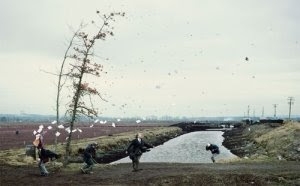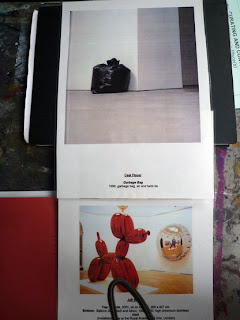New to me was Turner Prize winner (2004) Jeremy Deller, who controversially admitted he had no "artistic talent", but he could organise things - for example, in 2009 a procession to celebrate Manchester's "everyday culture" - including Big Issue sellers, Goths, modified cars, and "homage to the chip" to celebrate the world's first chip shop -
 see a 9-minute video here (warning: starts with an advert).
see a 9-minute video here (warning: starts with an advert).Then it came to the matter of displaying art works - what needs to be considered. Curatorial concerns are that "all aspects of display can affect the meaning of art works" - for example, Jeff Wall displays his photos in lightboxes, to give them an aura that separates art from the ordinary. I'm very fond of his "A Sudden Gust of Wind (after Hokusai) -
 Relationships of one work to another can be important too - for example, when setting out collections thematically - fans of Monet's Water Lilies might be upset to see them displayed next to a stone circle by Richard Long...
Relationships of one work to another can be important too - for example, when setting out collections thematically - fans of Monet's Water Lilies might be upset to see them displayed next to a stone circle by Richard Long... Our task, in small groups, was to analyse how putting works together would affect their meaning and function; find a theme that links them, and give the exhibition a title; and decide what other art works might be shown with them. Here are an inflated bin bag by Ceal Floyer, and Balloon Dog, and Moon, by Jeff Koons - our title was Inflation and referred not just to the air within the items (though the balloons are metal in the sculpture) but to the value of the art works.
Our task, in small groups, was to analyse how putting works together would affect their meaning and function; find a theme that links them, and give the exhibition a title; and decide what other art works might be shown with them. Here are an inflated bin bag by Ceal Floyer, and Balloon Dog, and Moon, by Jeff Koons - our title was Inflation and referred not just to the air within the items (though the balloons are metal in the sculpture) but to the value of the art works.  Then, the politics of display, and the artist of note was Maurizio Cattelan, memorable for his "Pope hit by Meteor" at the Royal Academy some years ago -
Then, the politics of display, and the artist of note was Maurizio Cattelan, memorable for his "Pope hit by Meteor" at the Royal Academy some years ago - In regard to the "white cube" gallery as a "framing device" for art, the artist example was Michael Asher, who alters the actual building, so that the viewer is actually entering the space of the artwork.
In regard to the "white cube" gallery as a "framing device" for art, the artist example was Michael Asher, who alters the actual building, so that the viewer is actually entering the space of the artwork.Land art and earth works - Robert Smithson's Spiral Jetty, Nancy Holt's Sun Tunnels, both from the early 1970s. And James Turrell's Sky Spaces.
Less excitement (but rather more chaos) in the afternoon, as we continued painting our coloured squares - enlarging them.
 At least we shared palettes, so rather less paint was wasted.
At least we shared palettes, so rather less paint was wasted.
2 comments:
Several years ago, the ethnographique's museum, in Neuchâtel, ask the same question : *what is the use of museum, and what is the right of choise of the good to be exibit *. Very interesting question.
The point was, anything could be exibit, just the matter how to present it.
They put stupid thing as for exemple * une boîte de conserve* under glas window.
About *spiral Jetty*, Hunderswasser had down it in his paintins. When her was teaching in a big school in Germany, maby Berlin, dont remember, her had draw a spirale on the wall and carry on, continuing on the street.
Béatrice.
Post a Comment